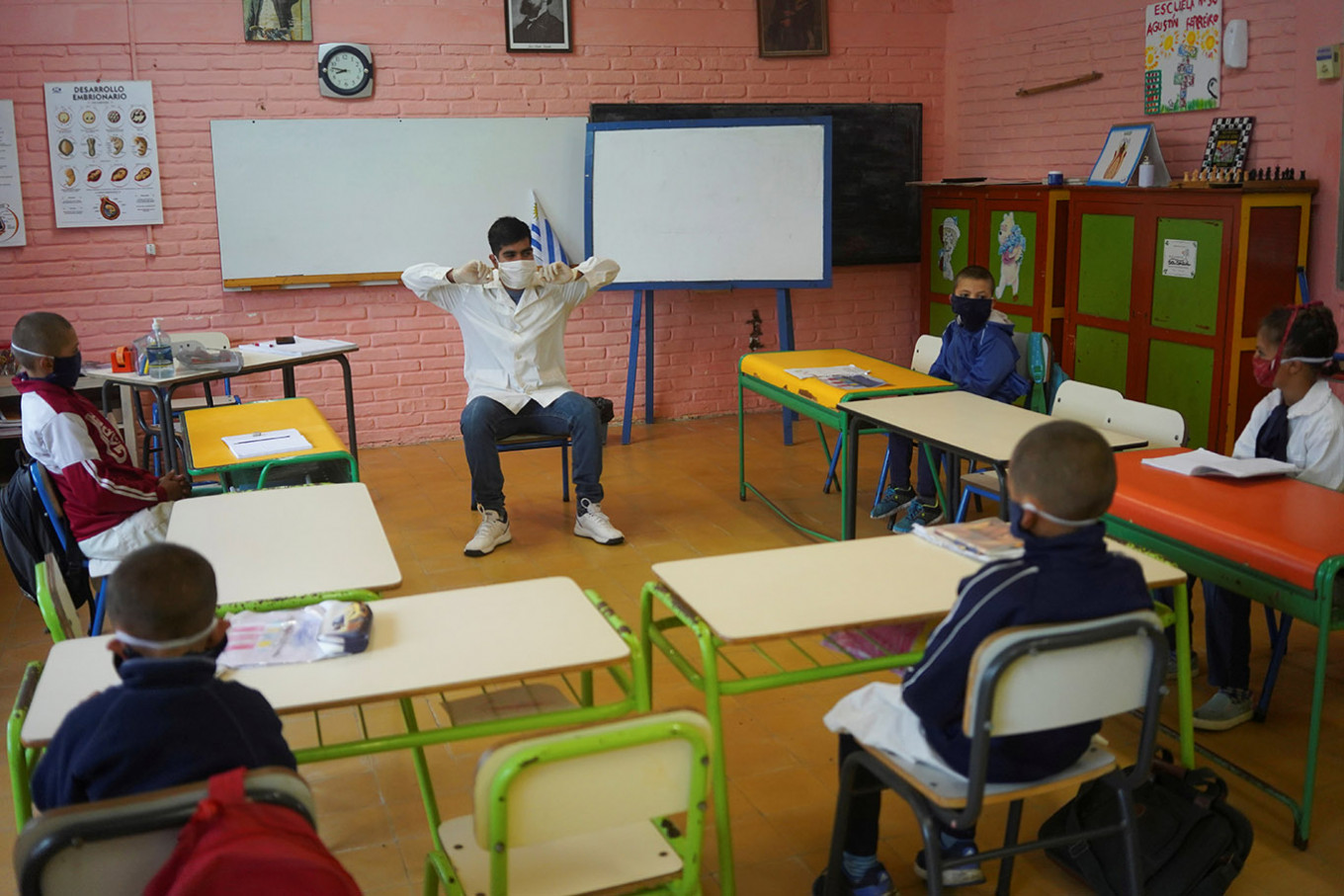Popular Reads
Top Results
Can't find what you're looking for?
View all search resultsPopular Reads
Top Results
Can't find what you're looking for?
View all search resultsUruguay and Costa Rica: Beacons of Latin American virus success
Change text size
Gift Premium Articles
to Anyone
 Teacher Sergio Ferrao gives instructions to students on how to wear a face mask at Escuela 30, a rural school that has resumed classes after a month off due to the COVID-19, in San Jose, Uruguay on Friday. Despite never declaring a general lockdown, Uruguay had recorded 749 cases and 20 deaths by Thursday among a population of 3.4 million.
(REUTERS/Mariana Greif)
Teacher Sergio Ferrao gives instructions to students on how to wear a face mask at Escuela 30, a rural school that has resumed classes after a month off due to the COVID-19, in San Jose, Uruguay on Friday. Despite never declaring a general lockdown, Uruguay had recorded 749 cases and 20 deaths by Thursday among a population of 3.4 million.
(REUTERS/Mariana Greif)
I
n Latin America, a region experiencing ever-increasing growth in the number of coronavirus infections and deaths, Uruguay and Costa Rica stand out as success stories.
Despite never declaring a general lockdown, Uruguay had recorded 749 cases and 20 deaths by Thursday among a population of 3.4 million.
In Costa Rica there have been just 903 cases and 10 deaths in a country of five million.
The numbers don't lie, and the outbreak in Uruguay "is currently under control," said epidemiologist Julio Vignolo, citing the country's rapid response.
The same day that Uruguay recorded its first four cases, March 13, the government declared a health emergency, shuttering schools and closing borders.
The government also encouraged voluntary isolation, which was widely adopted in a country with low population density.
Intensive care units have spare beds and the health system has never come close to creaking, let alone collapsing.
On Thursday, President Luis Lacalle Pou announced schools will resume classes in June, saying "we are convinced that the risk is minimal."
Uruguay's reproduction number -- the rate of infection -- is 0.74, according to a model developed by engineer Andres Ferragut and mathematician Ernesto Mordecki, who are working with the government as advisors. Anything under 1.0 means the infection is under control.
"In an ideal world" that means the virus will disappear from the country, Ferragut told AFP.
"It depends on a ton of things: the natural contagiousness of the virus but also societal behavior and the measures taken."
On March 29 visits to cafes, theaters and shopping centers were down 75 percent, while visits to parks, beaches and public squares were down 79 percent, according to a report by Google Mobility.
However, there are fears that with success comes complacency.
Those two figures had dropped to 36 and 53 percent respectively in Google Mobility's latest report on May 9.
"This is day to day. We need to be prudent, cautious," said Vignolo.
"Coronavirus has come to stay" and will be here "until there is a comprehensive solution."
Aiming for self-sufficiency
In Costa Rica, scientists and laboratories have been working on a range of solutions to tackle the outbreak, not least to reduce the country's dependence on imported goods amid global scarcity.
Costa Rica's success in warding off the novel coronavirus can be attributed to the involvement of all sectors of government, a quick response, and a strong health care system as well as the commitment of its citizens, said Maria Dolores Perez-Rosales, the World Health Organization representative in Costa Rica.
"Therein lies the key, in broad strokes, to why Costa Rica is managing the pandemic in this way," she said.
The country has done so well that it's the first in the region to have restarted its football league, albeit behind closed doors.
Costa Rican scientists have developed protective equipment, ventilators, capsules to transport infected patients and even specialized medication.
The arrival of the disease prompted a combined effort by the private and public sectors to work together "in order to achieve self-sufficiency in medical equipment," Science and Technology Minister Adrian Salazar told AFP by video.
Salazar says those efforts ensured that Costa Rica was sufficiently stocked with needed medical supplies.
While the mortality rate has been low, Costa Rica has still been preparing for the worst-case scenario, developing ventilator prototypes that are in the final stage of testing.
It's also made progress in testing and the production of swabs used to carry out the tests.
"The main goal is to be able to produce swabs locally given there's scarcity on a global level ... and if necessary, do widespread testing for COVID-19," said Jose Pablo Carballo, a student at the University of Costa Rica involved in the development program.









